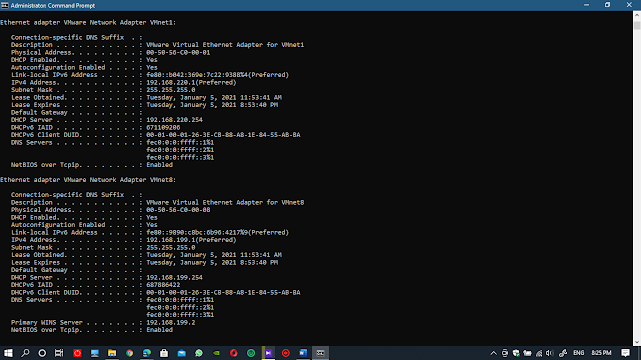"ipconfig" Command
ipconfig is a command line utility
available on all versions of Microsoft Windows starting with Windows NT.
ipconfig is designed to be run from the Windows command prompt. This utility
allows you to get the IP address information of a Windows computer. It also
allows some control over active TCP/IP connections. ipconfig is an alternative
to the older 'winipcfg' utility.
You can see status of your different network adapters, their IPv4 & IPv6 addresses, subnet masks and default gateways etc.
"ipconfig /all" Command
This option displays the same IP
addressing information for each adapter as the default option. Additionally, it
displays DNS and WINS settings for each adapter.
"Ping" Command
The ping command is a Command Prompt
command used to test the ability of the source computer to reach a specified
destination computer. The ping command is usually used as a simple way to
verify that a computer can communicate over the network with another computer
or network device.
The ping command operates by sending
Internet Control Message Protocol (ICMP) Echo Request messages to the
destination computer and waiting for a response.
How many of those responses are returned,
and how long it takes for them to return, are the two major pieces of
information that the ping command provides.
For example, you might find that there are
no responses when pinging a network printer, only to find out that the printer
is offline and its cable needs replaced. Or maybe you need to ping a router to
verify that your computer can connect to it, to eliminate it as a possible
cause for a networking issue.
Type “ping 192.168.1.1”
(give your routers IP address or any other IP address in same network). Now you
can check whether you’re your Router is communicating with your PC as expected.
If it gets 0% loss of data packets, that means communication between the Router
& PC is better.
"tracert" Command
The 'tracert' command is a Command Prompt
command that's used to show several details about the path that a packet takes
from the computer or device you're on to whatever destination you specify. You
might also sometimes see the tracert command referred to as the trace route
command or traceroute command.
Type “tracert
www.facebook.com” (give any website address). Wait until the Tracing process
complete. It show several details about the path that a packet takes from the
computer or device you're on to whatever destination you specify.
"getmac" Command
Media
Access Control Address (MAC Address) is a unique identifier assigned to network interfaces
for interactions on the physical network part. MAC addresses are used as a
network address such as Ethernet. Internet connection is an important part of
your Computer. Mac Address is a part of the Internet Network Connection. When
you enter to the Internet, that time, Internet Connection depends on the MAC
Address of the Network MAC Address. Usually, MAC Address is generated
automatically in your Lan Card in your Computer. Usually, MAC Address is unique
Network Address. MAC Address stays with your Motherboard Build In Lan Card.
Sometimes, some people use External Lan Card in their Computer. They also get a
MAC Address for their Internet Network Connection. MAC Address is used to
identify a Unique User of a Computer for a Location. Usually, MAC Address helps
you to identify a Unique Computer User from a Country or Location. MAC Address
can not be Match to one Computer User to another Computer User. getmac is a
Windows command used to display the Media Access Control (MAC) addresses for
each network adapter in the computer.
Type “getmac” and press
enter. It will display the Media Access Control (MAC) addresses for each
network adapter in the computer.
Microsoft Loopback Adapter
Microsoft
Loopback Adapter is a dummy network card, no hardware is involved. It is used as a testing tool for a
virtual network environment where network access is not available. Also, you
must use the Loopback adapter if there are conflicts with a network adapter or
with a network adapter driver. You can bind network clients, protocols, and
other network configuration items to the Loopback adapter, and you can install
the network adapter driver or network adapter later while retaining the network
configuration information. Then you will have a network card that will allow
applications (such RDBMS) to be installed. After installation you need to set
an IP address to it. A good IP
address would be 10.10.10.10 and 255.255.255.0 as mask. General
recommendation is something like 192.168.1.1, but I have seen many DHCP servers
where the gateway is 192.168.1.1 and this means that your internet connection
will not work.
Testing a Network Adapter using a Loopback Address
A
loopback address is an address that tells the computer not to test its
connections to another computer, but to test its own basic network setup. Ping
127.0.0.1 tests the IP stack, is the TCP/IP stack configured and working. Basically pinging the loopback just lets
you know that the TCP/IP has loaded at run time.
Type “ping 127.0.0.1”. If
you get 0% loss of data packets. That means your network adapter & network drivers are working well.









